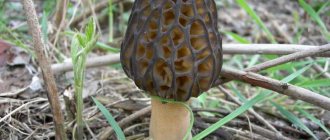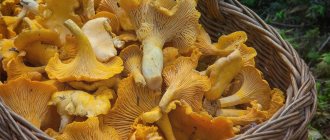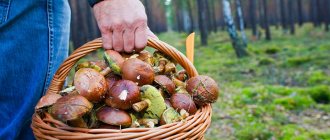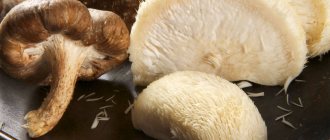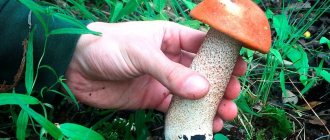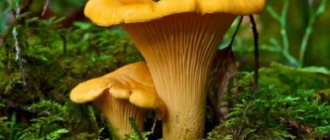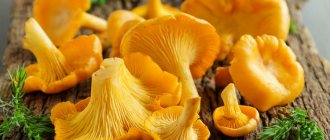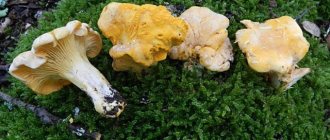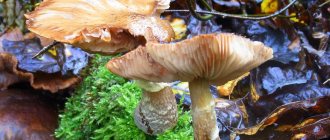Russia is rich in forests, and mushroom picking is a traditional occupation of Russians. Suitable mushroom places can be found even in the vicinity of the Russian capital. But not everywhere you can pick mushrooms anymore. Air and soil pollution can make the mushroom dangerous to health, because, unlike plants, it, like a sponge, absorbs almost any chemicals dissolved in water. In this article you will learn about the best mushroom places in the forests of the Moscow region. You can also read in the article about which places to avoid. And also about where the most mushrooms grow, what features these places have and how to get there.
Vegetation of the area
The Moscow region is rich in forests, which are home to almost all mushrooms. Forests cover slightly less than half of the region's territory. These are mainly mixed forests. They are most typical for the central and western parts of the region. In the east, coniferous forests of spruce, spruce with pine and pine are not uncommon. There are also forests with a large proportion of small-leaved (sometimes broad-leaved) species with pronounced undergrowth and dense grass cover. The forest vegetation of the northern part of the Moscow region is more consistent with the southern taiga zone.
In the southern part of the region there are broad-leaved forests and agricultural lands.
The species composition of the forest affects the growth characteristics and species composition of mushrooms.
What mushrooms grow in the Moscow region?
In the forests of the Moscow region you can find many different mushrooms. Based on value, local mushroom pickers divide them into 4 categories:
- The most valuable and high-quality mushrooms are porcini mushrooms and 2 types of milk mushrooms: real and yellow. They are considered the most delicious.
- Quite valuable mushrooms: champignons, chanterelles, boletus, boletus, podgruzdok.
- Mushrooms of medium quality: honey mushrooms, butterdish, morel, russula.
- Mushrooms of low quality, which should not be collected unless absolutely necessary, include hedgehog mushroom, violin mushroom, forest champignon, pepper mushroom, false honey mushroom and others.
In addition to edible and relatively edible mushrooms, there are also poisonous ones. The most poisonous is the toadstool. And besides it: ordinary stitch, false milk mushrooms, brick-red honey mushrooms.
There are other poisonous mushrooms that it is advisable to know and be able to distinguish from edible ones. This will minimize the risk of poisoning.
White Volnushka, or Whitefish
The surface of the cap is white, the middle of the surface is dark, the edges are strongly curled in the young mushroom. The cap is first convex, then becomes funnel-shaped, with a mucous surface. The surface also has a peculiar, felt-like covering of a mass of hairs. It is especially well developed in young mushrooms and along the edges of the cap. The surface of old mushrooms may turn yellow. Concentrically, the zones visible on the cap of the pink moth are at the c. white are practically invisible.
By the way. The length of the leg depends on the habitat. So, in specimens growing in open areas, the stalk is very short and reaches 2-4 cm, but if the mushroom grows in thick and tall grass, its height can reach 8 cm.
The pulp is brittle, white, and its taste is imparted by acrid white milky juice. The aroma is sweetish and pleasant.
Description of the white mushroom
What you need to know when picking mushrooms in the Moscow region
In the Moscow region, the first mushrooms appear after warm and humid weather sets in. Most of them can be found in August and July. By visiting mushroom places in the Moscow region during the season, you will get an excellent harvest. The best time for quiet hunting is early in the morning. At this time, mushrooms are freshest and last longer. You must also be sure that the mushroom is not poisonous. Some dangerous mushrooms may look like edible ones. You should also consider the following recommendations from experienced mushroom pickers:
- You should not take mushrooms that are too old and flabby.
- Collecting mushrooms near highways and railway lines is strictly not recommended due to the increased content of harmful substances in the air and soil.
- You should not pick mushrooms in the immediate vicinity of cities, especially large ones. The same applies to landfills and industrial plants, as well as to areas where industrial or military waste is buried.
- You should also not take mushrooms and canned mushrooms from unknown private sellers, since it is unknown where they were collected and how they were prepared.
- Before transporting mushrooms, they should be cleared of debris and carefully placed.
Reshetnik or goat
The following features are characteristic of the goat mushroom or dry oiler:
- the skin from the cap either comes off very poorly (in pieces) or does not come off at all;
- the surface of the cap, in comparison with other species of kids, has little mucous membrane, which is clearly reflected in the specific name of the synonym;
- the layer of hymenophore tubules smoothly descends from the lower surface of the cap to the stalk;
- the pores of the tubes are large, have a peculiar irregular angularity and torn edges;
- The pulp at the beginning of growth is dense and elastic, by the time of aging it becomes rubbery. Its pale yellow color in the cap may turn slightly red (pink) if the integrity of the surface is damaged.
- the leg is often curved closer to the base, sometimes narrowed downwards.
The shape of the cap of young mushrooms is convex, but for old ones it is already flat or cushion-shaped. Smooth to the touch and slightly sticky.
After heat treatment, the pulp of the mushroom becomes pinkish-purple.
Yellow-brown or orange-brown color. Reshetnik has no pungent taste and is slightly sour.
Where can you find mushrooms in the Moscow region?
Judging by the reviews, the best mushroom places in the Moscow region are spruce, pine, oak and birch forests. Mushrooms are less common under mountain ash, alder and poplar.
They can grow both on the ground and on the surface of growing or dead trees, as well as on stumps and trunks.
If you need honey mushrooms, experienced mushroom pickers advise looking for decaying, decaying wood. Mushrooms can be seen under the forest floor near rotting trees.
Morels prefer burning, feeding directly from the ashes.
In the dense forests of the Moscow region, in thickets and tall grass glades, mushrooms are rarely found.
Meadow honey mushrooms
Meadow honey mushrooms belong to the Negniuchnikov family and grow in a meadow or other open area. The cap is round, changing shape during growth until it is almost prostrate, but retains a tubercle in the center. The yellowish-brown color may show faint zoning.
The leg is thin, long, slightly tortuous. The pulp is pale yellow and thin. The hymenophore plates are located quite sparsely. Honey mushrooms have a distinct clove aroma and sweet taste.
The most mushroom places in the forests of the Moscow region
To search for mushroom places, it is recommended to choose one of the directions of the Moscow Railway. Before you start collecting, you should move some distance away from the railway, and also stay away from highways and industrial enterprises. In addition, as follows from the reviews, it is better to visit mushroom places in the Moscow region by car - this will provide the opportunity to quickly move to another place and not be left without the desired harvest.
If you believe the words of experienced mushroom pickers, one of the best destinations for searching for mushrooms is Ryazan. You can stop at the following stations: Shchurovo, Chernaya, Lukhovitsy. Here you can find a large number of chanterelles and boletus. In the photo, mushroom places in the Moscow region look good.
Mushrooms in the Istra region
There are many mushrooms and mushroom pickers in this area. People say that they collect the gifts of the forest in baskets. Most often, a rich “harvest” is collected northeast of Nazarovo.
You can get to the place by public transport. First, by train from Rizhsky station to the station. Rumyantsevo. From there they go to Nazarovo by bus, which leaves in the morning and afternoon.
By personal transport you need to get to the village. Rumyantsevo along the Volokolamsk or Novorizhskaya highway from the Moscow Ring Road. Then turn left, get to Kurovo, and then to Nazarovo. You can also pick mushrooms in the area itself.
Mushroom place in Dmitrovsky district
Boletus, aspen, porcini mushrooms, honey mushrooms, milk mushrooms, trumpets, russula, and sometimes saffron milk caps grow here. In the valley of the Klubish River, between the villages of Staro and Khoroshilovo, as experienced mushroom pickers say, you can collect a rich harvest of forest gifts.
You can get there by train from Savyolovsky station. Or by car along the Dmitrovskaya highway to the village. Iksha. There is Tekhnologicheskaya Street in it - we turn onto it. Then we cross the village of Khoroshilovo, behind which the forest begins.
Volnushka pink
The mushroom cap is round, in young ones it is convex, but over time it flattens, as a result of which a depression is formed in the center, which is called “umbilical”. There is a small amount of mucus on the surface. The skin covering the cap is equipped with thick and quite coarse-structured villi, which, arranged in circles, create the impression of a concentric pattern. It has a peculiar gray-pink color, which fades in dry weather, becoming almost white, which can lead to confusion and mushroom pickers will mistake the appearance for a white wave.
The pulp is white, strong, dense, and has a pungent taste. The pink trumpet, as a representative of the Milky genus, is characterized by the presence of abundant white milky juice with a pungent taste, which does not change color even when in contact with air.
The leg is large, solid, thick and very dense. In young mushrooms it is solid; in adults, cavities appear in it. It is painted pale pink. The leg narrows towards the base. Its surface is velvety to the touch due to the fluff covering it.
Top mushroom areas
What are the most mushroom places in the Moscow region? In principle, in almost every district of the Moscow region there are many excellent places for a successful “quiet hunt”. According to the magazine “Mushroom Picker of Russia”, the regions richest in mushrooms are Ruzsky, Stupinsky, Egoryevsky, Odintsovo, Klinsky, Dmitrovsky, Kolomensky and Orekhovo-Zuevsky. What can a mushroom picker count on in each of them?
In the Stupino region, judging by the reviews, you can find a lot of porcini mushrooms, boletuses and honey mushrooms. In total, there are several mushroom places in the area with good transport accessibility. It is easy to get there by electric train, which runs from Paveletsky station. You should get off at the station. Mikhnevo. If you move west from the station, then after 3.5 km you will find yourself in a forest where you can collect boletus mushrooms. If you go east, then after about 3 km there will be a forest rich in mushrooms. Here you can find boletus, nigella, valui, and russula in large quantities.
In the Ruza region you can collect a lot of honey mushrooms. This area is considered ecologically clean and is known for its forests. There are the most mushrooms near the settlements of Oreshek and Novovolkovo. You can get there by bus No. 25 from the city of Ruza (stops: “Luzhki”, “Sevvodstroy”, “Rakitino”). If you go to Oreshek, then take bus No. 26. In this case, you need to head for the village of Vertoshino. Here in the young aspen forest, if you believe the reviews, you can find a lot of honey mushrooms.
In the Yegoryevsky district, boletus mushrooms, porcini mushrooms, boletus mushrooms, chanterelle mushrooms, boletus mushrooms, greenfinches and others grow. You need to get to one of the villages: Vereika, Savvino, Shuvoe, Kostino, Bolshoye Gridino or to the village of Ryazanovsky. Experienced mushroom pickers warn: you can get lost in these forests, and there are quite a lot of snakes in them. Therefore, you should take high boots, a map, a compass, GPS and be careful.
In the Dmitrovsky district, boletus, boletus, chanterelle, aspen, saffron milk caps, boletus, and russula grow. It's easier to get here with your own car. It is necessary to move to the village. Iksha along Dmitrovskoye Highway, then, before reaching the crossing, turn onto Tekhnologicheskaya Street and, having passed the village of Khoroshilovo, get out in the forest. Here, judging by the reviews, you can pick porcini mushrooms, honey mushrooms, boletuses, milk mushrooms, trumpet mushrooms, russula, and boletuses. Saffron milk caps are less common. Between the villages of Staro and Khoroshilovo flows the drying river Klubish, on the banks of which there are also a lot of mushrooms.
The forests of the Odintsovo district are rich in porcini mushrooms and honey mushrooms. The forests most frequently visited by mushroom pickers in this area are located 1 km south of the station. Larks. In the Butyn region near the Minsk highway there are a lot of honey mushrooms. But you shouldn’t pick mushrooms near the road! Another forest rich in mushrooms is located near the village of Khlyupino. They say there are a lot of mushrooms and mushrooms here.
The Meshchera lowland is rich in almost all types of edible mushrooms. The mushroom areas near the city of Roshali are especially famous. You can get to it from Moscow - by bus No. 376 from the station. metro station "Kotelniki", then take city bus No. 4 to the stop. "Leskhoz" and by bus No. 10 to the station. SNT Yubileinaya.
In the Klinsky district, not far from Klin, there is a real invasion of mushrooms during the mushroom season. It is very convenient to collect forest gifts here - they grow on both sides of the Leningradskoye Highway: in the direction of Solnechnogorsk - boletus, chanterelle and boletus. On the other side, in the Reshetnikovo area, there are boletus and white ones. You can collect white and aspen boletuses near the Dmitrovskoye Highway (you shouldn’t collect them near the highway itself!). Further along the route, as experienced mushroom pickers assure, you can find chanterelles and aspen boletuses.
In the Kolomna region, near the village of Shapkino, in a mixed forest grow: porcini mushroom, chanterelles, oyster mushrooms, 2 types of honey mushrooms, morels, russula, svinushki, white mushrooms, boletus, volushki, milk mushrooms, that is, almost all edible types of mushrooms. This area is located 8 km northwest of Kolomna. It is easier to get to the place by private car. Another mushroom point is 8 km west of the border of the city of Kolomna, near the village of Kolodkino. There is a large pond near it. It is also easier to get there by private car.
There are mushrooms in the Mytishchi region. There are chanterelles, honey mushrooms, morels, boletuses and aspen boletus here. All these places are located near the Dynamo shooting range, as well as in the forest near the road between Afanasovo and Terpigoryevo.
In the Orekhovo-Zuevsky district in the “Park” forest there are boletuses, chanterelles, aspen boletuses, and russula. In the Krutovsky forest, pigs, chanterelles, and russula grow. In Isaakievsky (pine forest) you can pick boletus, chanterelles, boletus, boletus, and russula. You can get to these places by public transport.
Gray row
This species is very often called hatched row in Russian. The cap is large (up to 10-12 cm in diameter), fleshy, has wavy edges, which may also be slightly torn. The shape is flat-convex, later prostrate, with a blunt tubercle in the center. Its surface is slightly sticky. The color is from light gray to dark gray, sometimes olive, the center is somewhat darker, covered with dark hairs arranged radially.
The plates are wide, sparse, and may be attached to the tooth (to the stem) or free. Their color changes with age from white to grayish with a characteristic yellowish tint.
The pulp is white, dense, has a sweetish taste and smell of fresh flour. The color of the flesh is white or grayish; when broken, it can acquire a yellowish tint. The leg is thickened at the base, has a cylindrical shape, and is covered with a powdery coating in the upper part. It can be described as deeply rooted, i.e. immersed in forest leaf litter or moss litter.
Gray rower forms mycorrhiza with pine trees.
The species has doubles:
- Pointed row: a poisonous species, the owner of a thin ash-gray cap with a conical tubercle in the center, greyish-colored plates and a burning taste of the pulp.
- Soap bark: an inedible species, characterized by a noticeable smell of cheap soap, pulp that turns red when broken, and a bitter taste. The tapering leg is covered with small blackish scales.
- The row is different: it is conditionally edible, with a green or brown cap, a white leg and an unpleasant odor.
- Ryadovka earthy: edible species, looks different from the river. gray, much smaller in size, the surface of the cap (fibers and scales are present), gray plates of the hymenophore, located less frequently.
